NACE Journal / Spring 2024
“Execution eats strategy for breakfast.”
This quote, widely attributed to legendary management guru Peter Drucker, is at best a paraphrase of his original reflection—but the point remains: Measuring execution and acting on performance gaps is key to successful strategy implementation.
A more current observation from Tony Elumelu, economist, philanthropist, and thought leader, concurs, stating that, “Strategy is important, but execution is everything.”
NACE24 Presenter
Mary Scott present findings from her most recent student study at NACE24 in “Students Speak Out on Recruiting Engagement: Expectations and Experiences.”As applied to early talent recruiting, execution—meeting, or better yet, exceeding, students’ expectations throughout their candidate experience—is demonstrably the “secret sauce” that drives successful results. With so many employers using the same recruiting playbook these days, it’s the quality of implementation that’s the differentiator.
Why do I make such a definitive statement? Because thousands of students have told me so through their survey responses (ratings, rankings, and commentary) over the years and increasingly so since the pandemic.
Why am I writing about this now? Because I consider execution to be the “elephant in the room” that is compromising many employers’ ability to recruit and hire targeted talent. Let me explain.
Execution and Authenticity: What COVID Taught Us
As a starting point for our analysis of the impact of recruiting execution on students’ perceptions of employers’ authenticity, take a look at Figure 1.
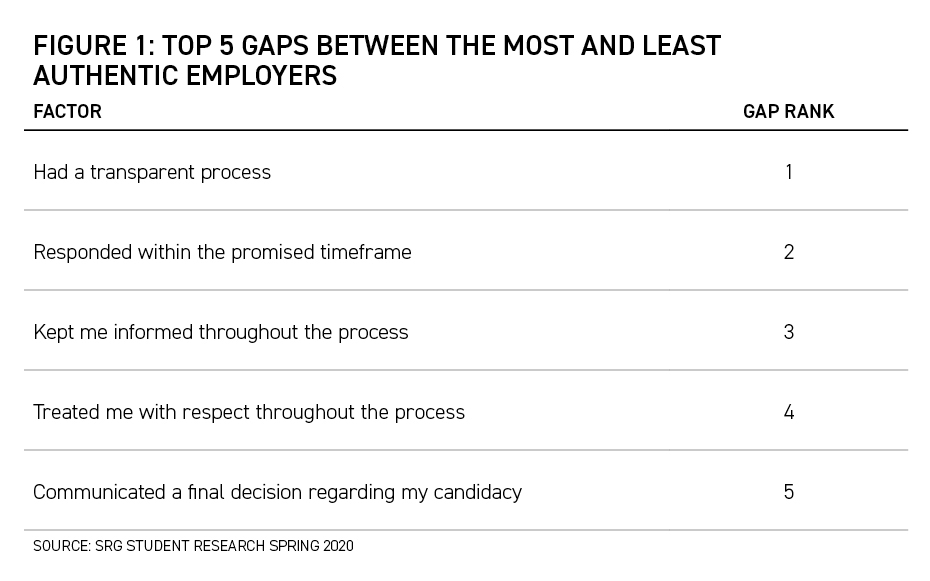
Populated with data gathered in March 2020, just prior to the shutdown of in-person campus recruiting, Figure 1 displays
how students assessed the biggest shortfalls between the most and least authentic employers’ recruiting practices. There were 36 elements students rated, distributed among people, process, and technology factors.
As you can see, all of the most significant shortfalls mapped to process execution, the same pattern that had surfaced in several Scott Resource Group (SRG) projects over a significant time horizon.
Given this, it came as no surprise to me that, in the first full semester of virtual recruiting (fall 2020), the factors “had a transparent process” and “treated me with dignity and respect” were among the biggest differentiators between the most and least impressive/authentic employers in a survey I conducted at the time. (See Figure 2.)
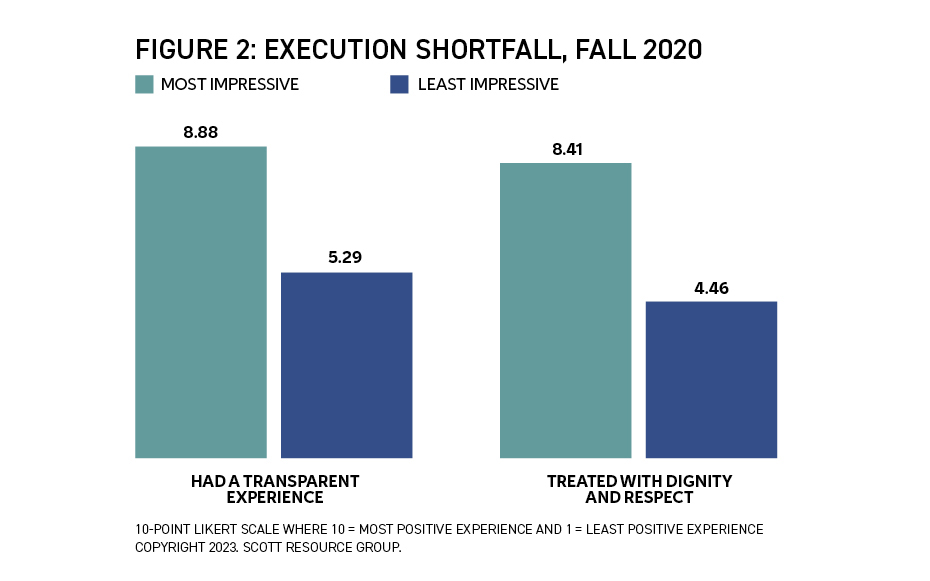
As we’ll see moving forward to the present, recruiting modality itself is not a key influencer specific to students’ assessment of their candidate experience. So, rather than revisiting the longstanding debate about “high touch” versus “high tech” engagement, I reframed the concept to one of “transactions” and “relationships,” and created “Scott’s Hierarchy of the Candidate Experience” to recast the impact of recruiting execution.
Execution and the Candidate Experience
With apologies to Abraham Maslow’s hierarchy of needs, the pyramid in Figure 3 depicts my visualization of the transactional and relationship components of the candidate experience. It builds from the bottom-most fundamental aspects of the transactional process steps of interacting with job applicants (respectfulness and transparency) through the relationship-building steps (engagement and authenticity). Note that I make no modality differentiation: These four building blocks of the candidate experience, each comprising four granular recruiting actions/behaviors, apply to both in-person and virtual recruiting.
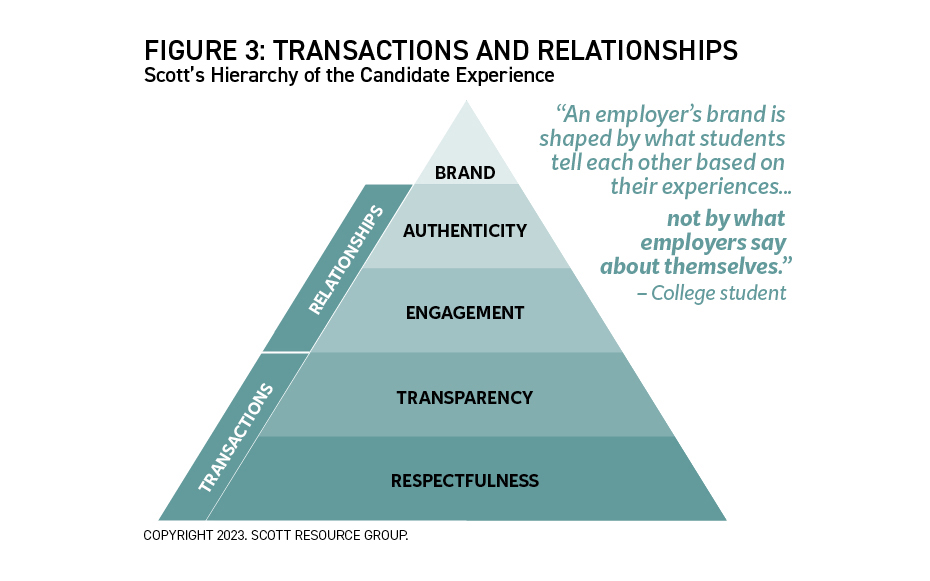
NACE Journal
For a deeper dive on authenticity, see Why Authenticity Is Essential to an Impressive and Effective Candidate Experience, in the Spring 2023 issue of the NACE Journal.The key takeaway from this pyramid is the student quote that accompanies it—that an employer’s campus brand is essentially the sum of the parts of how the student is treated throughout the candidate experience, and the candidate experience is foundational to its image as “a good place to work.”
Consider the four factor statements students rated in spring 2023 specific to the execution of the employers they identified as having the “most and least impressive candidate experience.” (See Figure 4.) Working left to right, one each representing respectfulness, transparency, and engagement measures, we see that these first three gaps are significant differentiators, culminating in an astonishing rightmost shortfall of 4.43 (on a 10-point Likert scale) in response to “made a genuine effort to build a relationship.”
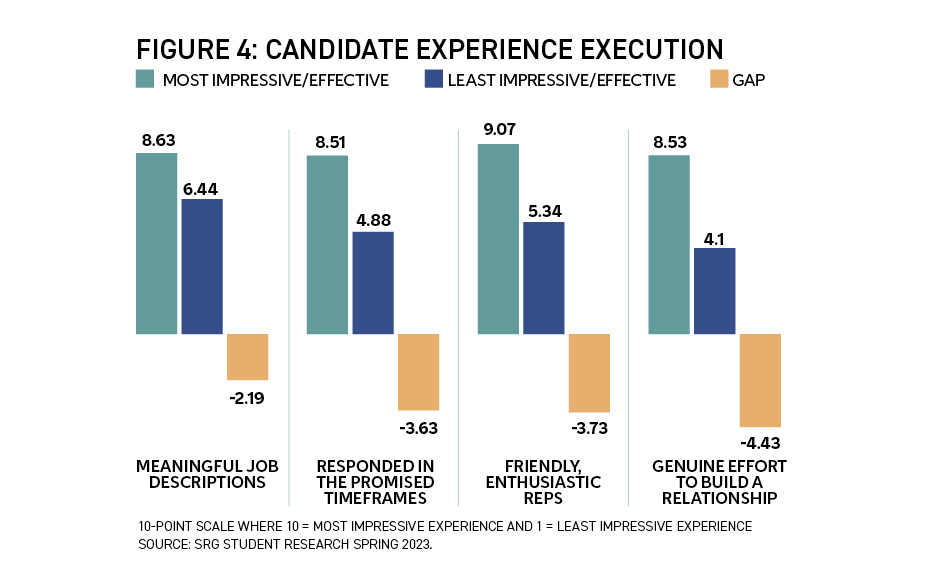
Why does any of this matter? Because as I’ve reported for as long as I’ve been researching students’ attitudes about their job search, their perceptions of how they’re treated throughout their candidate experience has a powerful influence on employer brand as “a good place to work.”
Being perceived as “a good place to work” by other students, former interns, recent hires, and so forth was clearly the most attractive employer attribute as rated by students who participated in SRG’s fall 2023 research project, significantly outdistancing having a “well-known consumer brand.” (See Figure 5.) This comparative chart also illustrates the importance of having a consistent campus presence, but that’s a topic for another day.

Specific to the impact of recruiting execution on employer brand, consider these two data points from spring 2022, asking students to rate their agreement with statements about the impact of the candidate experience on their perceptions of “what it’s like to work there,” and “desire to work there.” As Figure 6 indicates, Elumelu’s observation that “execution is everything” has consequences for early talent recruiting.
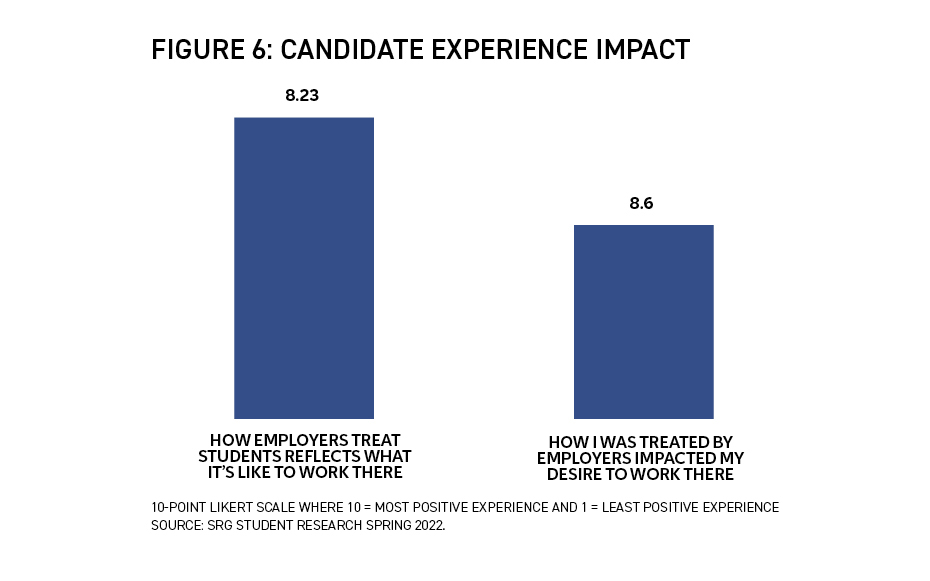
Strategy Is Important Too!
Lest we overlook the first part of Elumelu’s observation that “Strategy is important...,” my focus on execution is not to say that early talent recruiting strategy is irrelevant: Perish the thought!
However, consider this finding
from SRG’s fall 2023 research: When asked to assess 20 granular statements about the efficacy of the employer events they had attended this past semester, average ratings from students for format, content, and interaction with representatives
were all well within the “strong agreement” range (8.0+). (See Figure 7.) Process touchpoints, however, fell considerably short—and these benchmarks represent experiences with the most impressive and effective
employers.
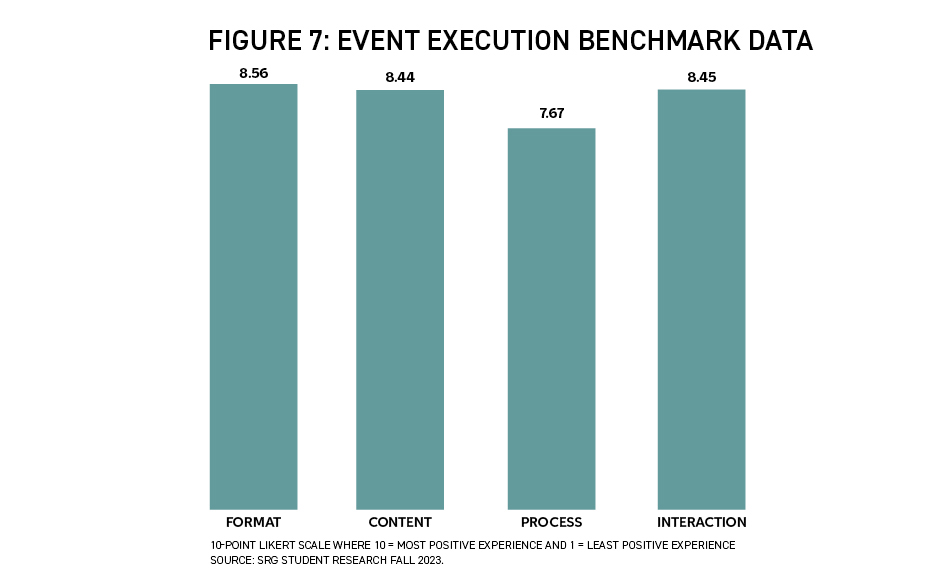
As examples of where execution fell short specific to process touchpoints among those evaluating their attendance at employers’ recruiting events, the two most significant gaps mapped to “gave specific details about next steps” and “connected after the event.” Talk about missed opportunities! It’s not at all difficult to connect the dots with the assumptions students have made specific to employers’ “being interested in me” over the past few years, in comparison with the 2019—pre-COVID—benchmark. (See Figure 8.)
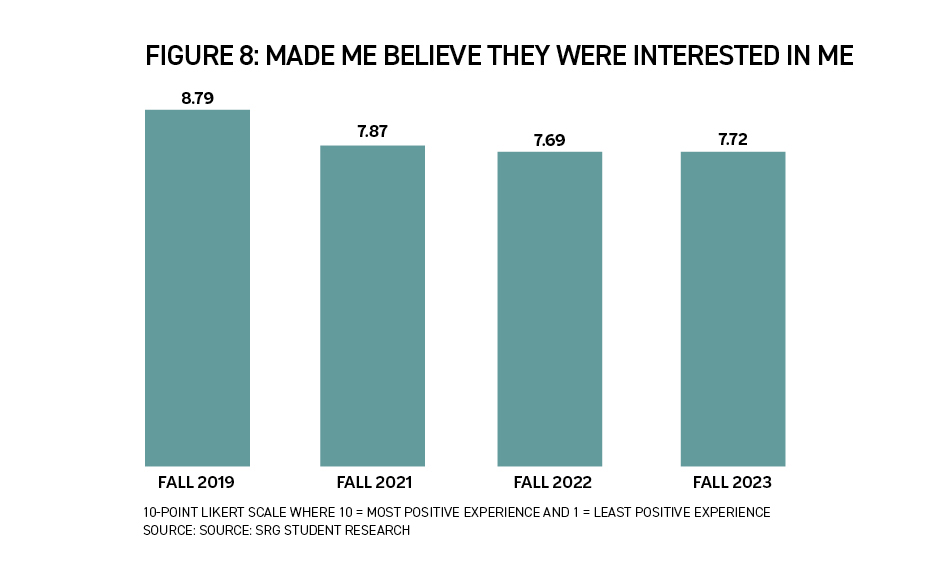
A different question set in the same fall 2023 Recruiting Engagement survey asked students to assess their use and valuing of 19 recruiting strategies frequently deployed on campus. The practice of “tabling” (setting up a table in a high-traffic area to attract students to learn about your organization and its opportunities) offers an excellent example of how execution is the differentiator, rather than the strategy itself.
Tabling was ranked fourth among the “most valued engagement/events” AND topped the list for the “least valued engagement/events.” It was execution that made the difference, as survey participants described their experiences: Tabling was highly effective when the representatives took advantage of the opportunity to connect one-on-one with students, but a total turn-off when the reps offered a tchotchke, pointed to a QR code for a resume scan, and then returned to scrolling through whatever was of more interest on their phones.
Why Is Execution Such a Challenge These Days? And What Can Be Done About It?
Having led a large-scale talent acquisition organization in a previous life, I can attest from personal experience that getting execution “right” is a multifaceted and continual challenge that requires constant vigilance. We hope (and want to believe) that all the moving parts are working as advertised, but in reality, everything and anything from system glitches to “rogue recruiters” to representatives not providing a positive interaction can and will occur.
Recruiting execution is hard. It’s not glamorous. We don’t give awards for those who do it well. And, while all of the above is hardly breaking news, the volume of applicants employers receive with the current agnostic approach to recruiting appears to have exacerbated an already challenging situation. What students value—personal connection and authenticity—is difficult to scale, and not meeting “blocking and tackling” expectations adds to the difficulty of successful strategy implementation.
It’s easy to assume (and I was guilty of falling into this trap) that “no news is good news” in regards to the full spectrum of recruiting execution. I learned the hard way that, conversely, we most likely won’t fix what we don’t know about.
So here’s why employers should make it a priority to seek candid and objective feedback about the impact of their recruiting processes, practices, and delivery. As Figure 9 illustrates, the interdependencies of execution and the candidate experience are linked to authenticity, and the powerful impact of same is described earlier in this article.
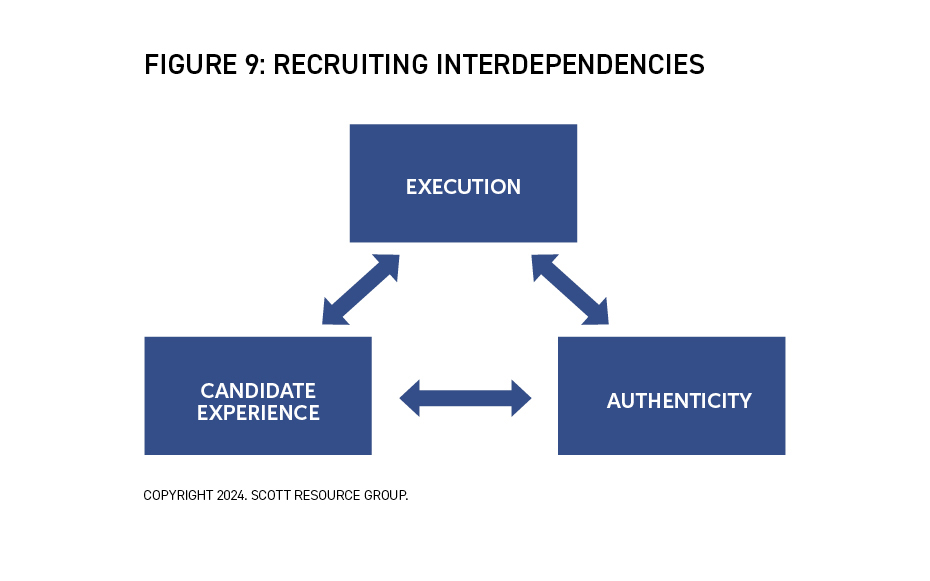
Why is execution such a challenge now? It seems that, as so many employers continue to struggle with significant candidate pipeline fall-off (along with offer declinations and reneges), students simply are not reacting with much enthusiasm to some of today’s recruiting strategies. And yes, that’s at least partially attributable to a reliance on virtual tools and diminished in-person engagement.
Rather than continuing to add new recruiting strategies and sources to the mix to offset shortfalls, my strong recommendation for employers is to first take a clear-eyed look through the students’ eyes at where your current execution is succeeding in meeting their needs and expectations—and where an honest ROI analysis suggests taking a different approach and investing resources to strengthen results.
There is no “one-size-fits all” template of strategies and tactics; every employer is different, as is every university. At the proverbial end of the day, even if that were not the case, students would still differentiate among employers based on the implementation of their strategies—because execution is indeed the secret sauce that drives successful university recruiting results.






